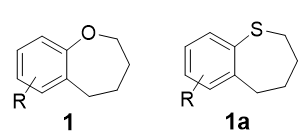Advances in the Synthesis and Pharmacological Applications of Heterocyclic Scaffolds: Benzoxepine and Benzothiepine Derivatives
DOI:
https://doi.org/10.59828/ijsrmst.v2i7.127Abstract
Paul Cagniant first reported the synthesis of benzoxepine which was named as homochroman 1.1 Since then a large number of substituted benzoxepine derivatives were prepared by various synthetic routes, the significant being (i) By rearrangement of anisylidine flavone epoxides;2 (ii) From dihydrobenzofuran-3-one;3 (iii) By PARHAM Cyclialkylation;4,5 (iv) From aryl oxazolines;6 (v) By ring closure of Isoprenyl terminal epoxides;7

Homochroman (1-Benzoxepine and 1-Benzothiepine)
(vi) By photocycloaddition of Benzo[b]furan derivatives to alkenes;8 and several other synthetic routes not being employed in common practice. The thia analog is known as benzothiepine 1a.
A review on Benzoxepines has described the synthetic routes reported in literature till 1990.9,10 The present review describes the synthetic routes, reactions, the naturally occurring 1-Benzoxepines, its derivatives and their pharmacological significance.
Keywords: Benzoxepine and Benzothiepine, synthetic routes, reactions, pharmacological significance.
Downloads
Published
Issue
Section
License
Copyright (c) 2022 International Journal of Scientific Research in Modern Science and Technology

This work is licensed under a Creative Commons Attribution-NonCommercial 4.0 International License.










